Untitled Document
 |
A view of an energy plant
west of Cologne March 27,2004 |
Extra precipitation expected as a result of global warming could create a lopsided
world in which sea ice increases around the South Pole while the far north melts
away.
A new study illustrates the difficulty in predicting how the planet might react
to overall warming, which most but not all scientists believe is underway, in
part due to greenhouse gas emissions by industry and autos.
"Most people have heard of climate change and how rising air temperatures
are melting glaciers and sea ice in the Arctic," said Dylan Powell of the
University of Maryland Baltimore County. "However, findings from our simulations
suggest a counterintuitive phenomenon. Some of the melt in the Arctic may be
balanced by increases in sea ice volume in the Antarctic."
Powell, a doctoral student, is lead author of a paper describing the results
in this month's Journal of Geophysical Research (Oceans).
Powell and his colleagues used satellite data from NASA's Special Sensor Microwave/Imager
to study snow depth on sea ice. The data allowed "more stable and realistic
precipitation data" to be fed into computer models that project changes
around the globe.
"On any given day, sea ice cover in the oceans of the polar regions is
about the size of the United States," said Thorsten Markus, a co-author
of the paper and a research scientist at NASA's Goddard Space Flight Center.
"Far-flung locations like the Arctic and Antarctic actually impact our
temperature and climate where we live."
Polar sea ice formation and climate patterns drive large ocean circulation currents,
which in turn affect local climates at moderate latitudes where most people
live. A warmer world should fuel more precipitation, most experts agree.
For Antarctica, the new study concludes, the extra precipitation will mean deeper
snow, which will suppress sea ice below, making it thicker over time.
The idea rusn counter to a study earlier this year that found glaciers in part
of Antarctica are melting rapidly.
"We used computer-generated simulations to get this research result,"
Powell cautioned. "I hope that in the future we'll be able to verify this
result with real data through a long-term ice thickness measurement campaign."

